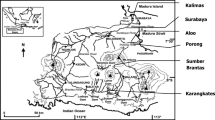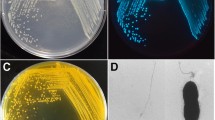Abstract
The disturbance of plasma membrane carbohydrates and of lipopolysaccharide (LPS) ligands in relation to cytoskeletal transformations of haemocytes has been investigated after chronic exposure of pond snails (Lymnaea stagnalis) to the peroxidizing toxicant fomesafen. Neither of the two lectins used (concanavalin A and wheat germ agglutinin) showed any binding modification after incubation of the snails in the presence of the toxicant. However, after exposure of the snails to fomesafen, a clear and persistent reduction in LPS labelling of haemocytes occurred. The actin cytoskeleton of the same cells also appeared to be sensitive to the toxicant. The reduction in LPS-binding sites was related to actin staining, leading to the hypothesis that LPS ligands and actin could be similarly modulated by the toxicant. Damaged cells showed non-adherent membrane portions with reduced filopodial extrusions, exhibiting a smooth surface free of microvilli. These changes could lower the spreading and adhesion of the cells and could therefore account for the loss in their phagocytic capabilities.








Similar content being viewed by others
References
Adema CM, Van Deutekom-Mulder EC, Van der Knaap WPW, Meuleman EA, Sminia T (1991) Generation of oxygen radicals in hemocytes of the snail Lymnaea stagnalis in relation to the rate of phagocytosis. Dev Comp Immunol 15:17–26
Bellomo G, Mirabelli F, Richelmi P, Malorni W, Iosi F, Orrenius S (1990) The cytoskeleton as a target in quinone toxicity. Free Rad Res Commun 8:391–399
Brown E (1995) Phagocytosis. Bioessays 17:109–117
Cambi A, Koopman M, Figdor CG (2005) How C-type lectins detect pathogens. Cell Microbiol 7:481–488
Cao A, Ramos-Martinez JI, Barcia R (2004) In vitro effects of LPS, IL-2, PDGF and CRF on haemocytes of Mytilus galloprovincialis Lmk. Fish Shell Fish Immunol 16:215–225
Caquet T, Deydier S, Lacroix G, Lesher-Moutoué F, Le Rouzic B (2005) Effects of fomesafen, alone and in combinaison with an adjuvant, on planktonic communities in freshwater outdoor pond mesocosms. Environ Toxicol Chem 24:1116–1124
Chow SC, Orrenius S (1994) Rapid cytoskeleton modification in thymocytes induced by the immunotoxicant tributylin. Toxical Appl Pharmacol 127:19–26
Costa SCP, Ribeiro C, Girard PA, Zumbihl R, Bréhelin M (2005) Modes of phagocytosis of Gram-positive and Gram-negative bacteria by Spodoptera littoralis granulmar haemocytes. J Insect Physiol 51:39–46
Couch L, Hertel LA, Loker ES (1990) Humoral response of the snail Biomphalaria glabrata to trematode infection: observation on a circulating hemagglutinin. J Exp Zool 255:340–349
Dikkeboom R, Tijnagel JMGH, Van Der Knaap WPW (1988) Monoclonal antibody recognized subpopulations in juvenile and adults Lymnaea stagnalis: functional characteristics and lectin binding. Dev Comp Immunol 12:17–32
Fagotti A, Di Rosa I, Simoncelli F, Pipe R (1996) The effects of copper on actin and fibronectin organization in Mytilus galloprovincialis haemocytes. Dev Comp Immunol 20:383–391
Hinshaw DB, Sklar LA, Bohl B, Schraufstatter IU, Hyslop PA, Rossi MW, Spragg RG, Cochrane CG (1986) Cytoskeletal and morphologic impact of cellular oxidant injury. Am J Pathol 123:454–464
Hoffmann JA, Kafatos FC, Janeway CA, Ezekowitz RA (1999) Phylogenetic perspectives in innate immunity. Science 284:1313–1318
Horak P, Van Der Knaap WPW (1997) Lectins in snails-trematode immune interactions: a review. Folia Parasitol (Praha) 44:161–172
Hughes TKJ, Smith EM, Barnett JA, Charles R, Stefano GB (1991) Lipopolysaccharide and opioids activate distinct populations of Mytilus edulis immunocytes. Cell Tissue Res 264:317–320
Janeway CA (1989) Approaching the asymptote? Evolution and revolution in immunology. Cold Spring Harb Symp Quant Biol 54:1–13
Kopacek P, Grubhoffer L, Söderhall K (1993) Isolation and characterization of a hemagglutinin with affinity for lipopolysaccharide (LPS) from plasma of the crayfish Pacifastacus leniusculus. Dev Comp Immunol 17:407–418
Lever J, Bekius R (1965) On the presence of an external hemal pore in L. stagnalis L. Experientia 21:1–4
Livingstone DR, Chipman JK, Lowe DM, Minier C, Michelmore CL, Moore MN, Peters LD, Pipe RK (2000) Development of biomarkers to detect the effects of organic pollution on aquatic invertebrates: recent molecular, genotoxic, cellular and immunological studies on the common mussel (Mytilus edulis L) and other mytilids. Int J Environ Pollut 13:56–91
Marinovich M, Sanghvi A, Colli S, Tremoli E, Galli C (1990) Cytoskeletal modifications induced by organotin compounds in human neutrophils. Toxicol In Vitro 4:109–113
Mirabelli F, Salis A, Vairetti M, Bellomo G, Thor H, Orrenius S (1989) Cytoskeletal alteration in human patelets exposed to oxidative stress are mediated by oxidative and Ca2+-dependent mechanisms. Arch Biochem Biophys 270:478–488
Ogden CA, De Catelineau A, Hoffmann PR, Bratton D, Ghebrehiwet B, Fadok VA (2001) C1q and mannose binding lectin engagement of cell surface calreticulin and CD91 initiates macropinocytosis and uptake of apoptotic cells. J Exp Med 194:781–795
Olafsen JA (1986) Invertebrate lectins: biochemical heterogeneity as a possible key to their biological function. In: Brehelin M (ed) Immunity in invertebrates. Springer, Berlin Heidelberg New York, pp 94–111
Petri WA, Haque R, Mann B (2002) The bittersweet interface of parasite and host: lectin-carbohydrate interactions during human invasion by the parasite Entamoeba histolytica. Annu Rev Microbiol 56:39–64
Pipe RK, Coles JA, Carissan FMN, Ramanathan K (1999) Copper induced immunomodulation in the marine mussel Mytilus edulis. Aquat Toxicol 46:43–54
Plows LD, Cook RT, Davies AJ, Walker AJ (2004) Activation of extracellular-signal regulated kinase is required for phagocytosis by Lymnea stagnalis haemocytes. Biochim Biophys Acta 1692:25–33
Renwrantz L (1983) Involvement of agglutinins (lectin) in invertebrate defence reaction: the immunobiological importance of carbohydrate-specific binding molecules. Dev Comp Immunol 7:603–608
Renwrantz L, Cheng TC (1977) Identification of agglutinin receptors on hemocytes of Helix pomatia. J Invert Pathol 29:88–96
Russo J, Lagadic L (2000) Effects of parasitism and pesticide-exposure on characteristics and functions of hemocyte populations in the freshwater snail Lymnaea palustris (Gastropoda: Pulmonata). Cell Biol Toxicol 16:15–30
Russo J, Lagadic L (2004) Effects of environmental concentrations of atrazine on hemocyte density and phagocytic in the pond snail Lymnaea stagnalis (Gastropoda, Pulmonata). Environ Pollut 127:303–311
Russo J, Madec L (2007) Haemocyte apoptosis as a general cellular immune response of Lymnaea stagnalis (Gastropoda, Pulmonata) to a toxican. Cell Tissue Res 328:431–441
Russo J, Orfila-Lefeuvre L, Lagadic L (2007) Hemocyte-specific responses to the peroxidizing herbicide fomesafen in the pond snail Lymnaea stagnalis (Gastropoda, Pulmonata). Environ Pollut 146:420–427
Sami S, Faisal M, Huggett RJ (1993) Effect of laboratory exposure to sediments contaminated with polycyclic aromatic hydrocarbons on the hemocytes of the American oyster Crassostrea virginica. Mar Envir Res 35:131–135
Schoenberg DA, Cheng T (1980) Lectin-binding specificities of hemocytes from two strains of Biomphalaria glabrata as determined by microhemadsorption assays. Dev Comp Immunol 4:617–628
Shi L, Takahashi K, Dundee J, Shahroor-karni S, Thiel S, Jensenius JC, Gad F, Hamblin MR, Sastry KN, Ezekowitz RA (2004) Mannose-binding lectin-deficient mice are susceptible to infection with Staphylococcus aureus. J Exp Med 199:1379–1390
Sminia T, Winsemius AA, Van Der Knaap WPW (1981) Recognition of foreignness by blood cells of the freshwater snail Lymnaea stagnalis, with special reference to the role and structure of the cell coat. J Invert Pathol 38:175–183
Stuart LM, Ezekowitz RA (2005) Phagocytosis: elegant complexity. Immunity 22:539–550
Stuart LM, Takahashi K, Shi L, Savill J, Ezekowitz AB (2005) Mannose-binding lectin-deficient mice display defective apoptotic cell clearance but no autoimmune phenotype. J Immunol 174:3220–3226
Syversen TLM, Sager PR, Clarkson TW, Cavanagh JB, Elgsaeter A, Guldberg HC, Duk Lee S, Lichman M, Mottet NK, Olmsted JB (1986) The cytoskeleton as a target for toxic agents. In: Clarkson TW, Sager PR, Syversen TLM (eds) The cytoskeleton. Plenum, New York, pp 25–34
Teixeira MM, Almeida IC, Gazzinelli RT (2002) Introduction: innate recognition of bacteria and protozoan parasites. Microbes Infect 4:883–886
Wittver D, Weise C, Götz P, Wiesner A (1997) LPS (5-lipopolysaccharide)-activated immune responses in a hemocyte cell line from Estigmene acraea (Lepidoptera). Dev Comp Immunol 21:323–335
Zelk U, Becker W (1992) Biomphalaria glabrata: influence of calcium, lectins, and plasma factors on in vitro phagocytic behavior of hemocytes of noninfected or Shistosoma mansoni-infected snails. Exp Parasitol 75:126–136
Acknowledgements
The authors thank the members of the INRA Laboratory, Ecotoxicologie Aquatique, Rennes. They are also grateful to Dr. L. Lagadic for his knowledge of toxicology and to M. Heydorff and D. Azam for technical help and for providing animals. The authors extend special thanks to J. Le Lannic for scanning microscopy assistance (Université Rennes 1, UMR 6553), to O. Kah (Université Rennes 1, UMR CNRS 6026-IFR140) for fluorescent microscopy assistance and to P. Charbonnier (Immunologie Cellulaire, Centre Hospitalier Universitaire Rennes) for flow-cytometric analysis.
Author information
Authors and Affiliations
Corresponding author
Rights and permissions
About this article
Cite this article
Russo, J., Madec, L. & Brehélin, M. Effect of a toxicant on phagocytosis pathways in the freshwater snail Lymnaea stagnalis . Cell Tissue Res 333, 147–158 (2008). https://doi.org/10.1007/s00441-008-0578-8
Received:
Accepted:
Published:
Issue Date:
DOI: https://doi.org/10.1007/s00441-008-0578-8




